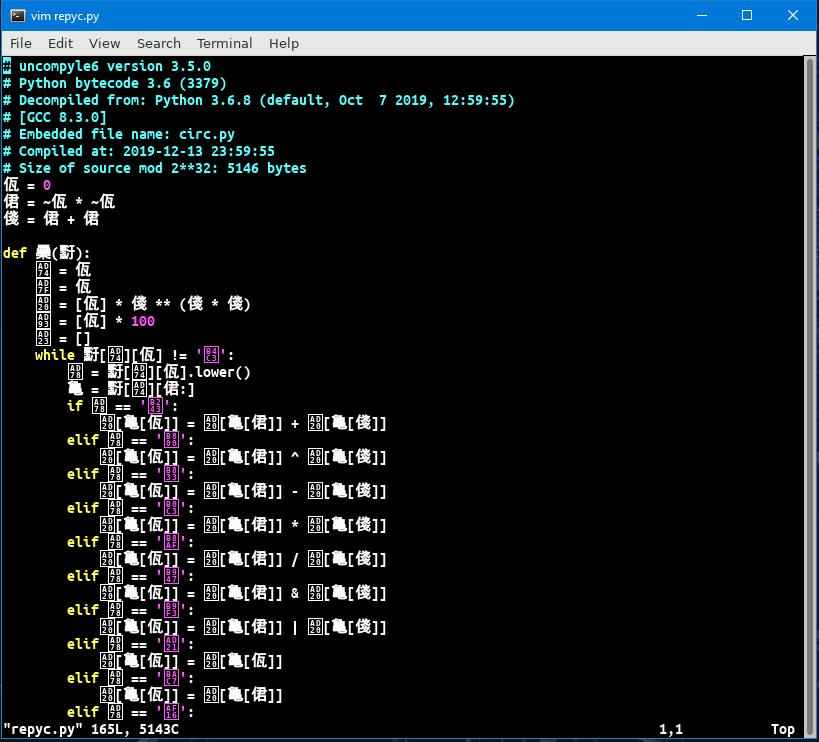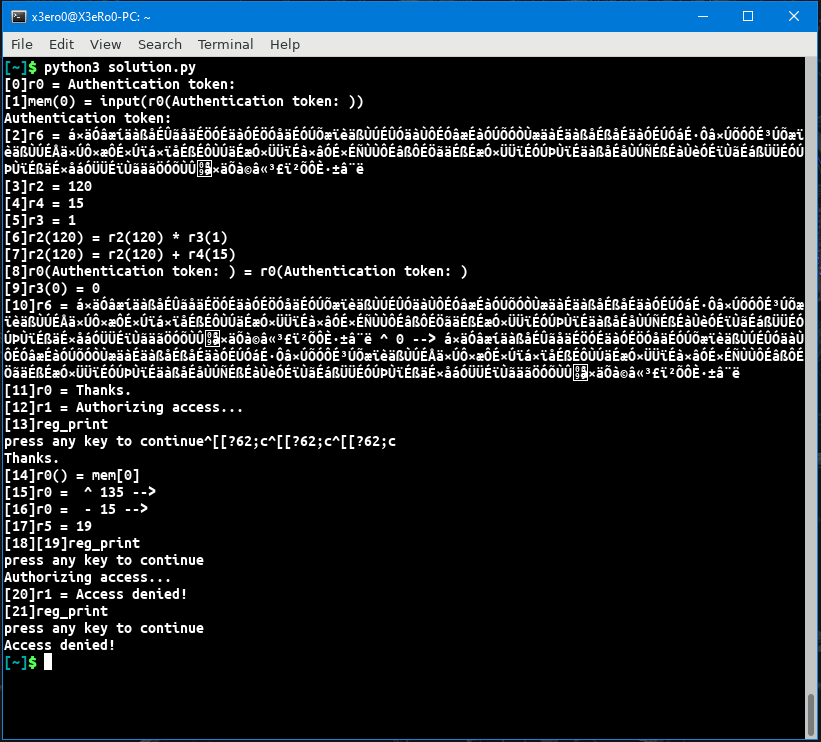Challenge: REPYC [REV] - 147 Points
Challenge Description:
- woo thi chal sooo repyc!
- File: 3nohtyp.pyc
- Difficulty estimate: Easy
We are given a pyc file and running file on this pyc reveals that its a python 3.6 compiled python bytecode.
1[~]$ file 3nohtyp.pyc
23nohtyp.pyc: python 3.6 byte-compiledso i went with the usuall approach to a python pyc challenge, where the first part is to decompile the bytecode.
i used uncompyle6 [~]$ uncompyle6 3nohtyp.pyc > repyc.py and the output was very weird just look at this file

I never thought that reversing a python source file would be so difficult. At first i thought maybe there is python obfuscator which obfuscates variable names with unicode Chinese looking charecters and there are a lot of other obfuscators which uses other techniques similar to this one but unfortunately i didn’t find any obfuscator which does this kind of obfuscation, i thought if i found the obfuscator maybe an unobfuscator also exists so that will make my work easier but i was wrong.
Some good obfuscators which i found are:
So the next thing i did was i started replacing each chinese charecter in the file with simple names like i translated first 3 lines like this
1佤 = 0
2侰 = ~佤 * ~佤
3俴 = 侰 + 侰
translated to
1A = 0
2B = ~A * ~A
3C = B + B
and finally
1A = 0
2B = 1
3C = 2
And later in the code instead of just using 1, 2 and 3 they use A, B and C so i replaced all the A, B and Cs with their respective values
then comes this function
1def 䯂(䵦):
At this point i already guessed it was a VM so i named this function VM(byte)
next we see some more declarations which turns out to be registers and memory and stack and stuff for example
괠 = [A] * C ** (C * C) translates to reg = [0] * 16
and 궓 = [A] * 100 translates to mem = [0] * 100
and after reading the rest of the code turns out 괣 = [] was the stack
so this part looks like this now
1A = 0
2B = 1
3C = 2
4
5def VM(byte):
6 var1 = 0
7 var2 = 0
8 reg = [0] * 16 # array of registers
9 mem = [0] * 100 # contains our input
10 stack = []
then there is a while loop
1 while 䵦[굴][A] != '듃':1 byte[var1][0] != '듃' and finally
1굸 = 䵦[굴][A].lower()
2亀 = 䵦[굴][B:]
translated to
1opcode = byte[var1][0].lower()
2_arg_ = byte[var1][1:]
and at this point it was time to analyse all the opcodes, so i used my big brain and only analysed the ones which were actually executed. when you see the call to the VM() function the arguments passed is a list of instructions for sat down and started to do find and replace on all the instructions. but then i noticed that the instructions in the bottom were not correctly indented so i fixed that and i ended up with this

after that i just did a lot of find and replace and i finally fixed the whole python file and i ended up with this VM Bytecode
1VM([
2 ['mov', 0, 'Authentication token: '],
3 ['mem_mov', 0, 0], # mem(r1) = r2
4 ['mov', 6, 'á×äÓâæíäàßåÉÛãåäÉÖÓÉäàÓÉÖÓåäÉÓÚÕæïèäßÙÚÉÛÓäàÙÔÉÓâæÉàÓÚÕÓÒÙæäàÉäàßåÉßåÉäàÓÉÚÓáÉ·Ôâ×ÚÕÓÔɳÚÕæïèäßÙÚÉÅä×ÚÔ×æÔÉ×Úïá×ïåÉßÉÔÙÚäÉæÓ×ÜÜïÉà×âÓÉ×ÉÑÙÙÔÉâßÔÉÖãäÉßÉæÓ×ÜÜïÉÓÚÞÙïÉäàßåÉåÙÚÑÉßÉàÙèÓÉïÙãÉáßÜÜÉÓÚÞÙïÉßäÉ×åáÓÜÜ\x97ÉïÙãäãÖÓ\x9aÕÙÛ\x99á×äÕà©â«³£ï²ÕÔÈ·±â¨ë'],
5 ['mov', 2, 120],
6 ['mov', 4, 15],
7 ['mov', 3, 1],
8 ['multiply', 2, 2, 3], # r2 = r2 * r3
9 ['add', 2, 2, 4], # r2 = r2 + r4
10 ['nop', 0, 2], # maybe nop
11 ['zero_reg', 3], # sets r3 = 0
12 ['xor_string', 6, 3],
13 ['mov', 0, 'Thanks.'],
14 ['mov', 1, 'Authorizing access...'],
15 ['print_reg', 0], # prints r0
16 ['reg2mem', 0, 0], # set r[arg0] = mem[arg1]
17 ['xor_string', 0, 2],
18 ['subtract_string', 0, 4],
19 ['mov', 5, 19],
20 ['strcmp', 0, 6, 5], # check strings ; if not equal r[7] = 1 ; push r[arg[2]]
21 ['print_reg', 1],
22 ['mov', 1, 'Access denied!'],
23 ['print_reg', 1],
24 ['hlt']])
clearly it loads this huge string into r6 and then xors it with 135 and then subtract 15 from each charecter and then compares with our input so i quicly wrote a decrypt function
1def find_flag():
2
3 b = 'á×äÓâæíäàßåÉÛãåäÉÖÓÉäàÓÉÖÓåäÉÓÚÕæïèäßÙÚÉÛÓäàÙÔÉÓâæÉàÓÚÕÓÒÙæäàÉäàßåÉßåÉäàÓÉÚÓáÉ·Ôâ×ÚÕÓÔɳÚÕæïèäßÙÚÉÅä×ÚÔ×æÔÉ×Úïá×ïåÉßÉÔÙÚäÉæÓ×ÜÜïÉà×âÓÉ×ÉÑÙÙÔÉâßÔÉÖãäÉßÉæÓ×ÜÜïÉÓÚÞÙïÉäàßåÉåÙÚÑÉßÉàÙèÓÉïÙãÉáßÜÜÉÓÚÞÙïÉßäÉ×åáÓÜÜ\x97ÉïÙãäãÖÓ\x9aÕÙÛ\x99á×äÕà©â«³£ï²ÕÔÈ·±â¨ë'
4 temp = ''
5 for i in range(len(b)):
6 temp += chr(ord(b[i]) + 15)
7
8 a = temp
9 temp = ""
10 for i in range(len(a)):
11 temp += chr(ord(a[i]) ^ 135)
12
13 print(temp)
and just after that i got the flag
1[~]$ python3 solution.py
2watevr{this_must_be_the_best_encryption_method_evr_henceforth_this_is_the_new_Advanced_Encryption_Standard_anyways_i_dont_really_have_a_good_vid_but_i_really_enjoy_this_song_i_hope_you_will_enjoy_it_aswell!_youtube.com/watch?v=E5yFcdPAGv0}
damn that flag is huge and i also wonder whats up with these youtube links?